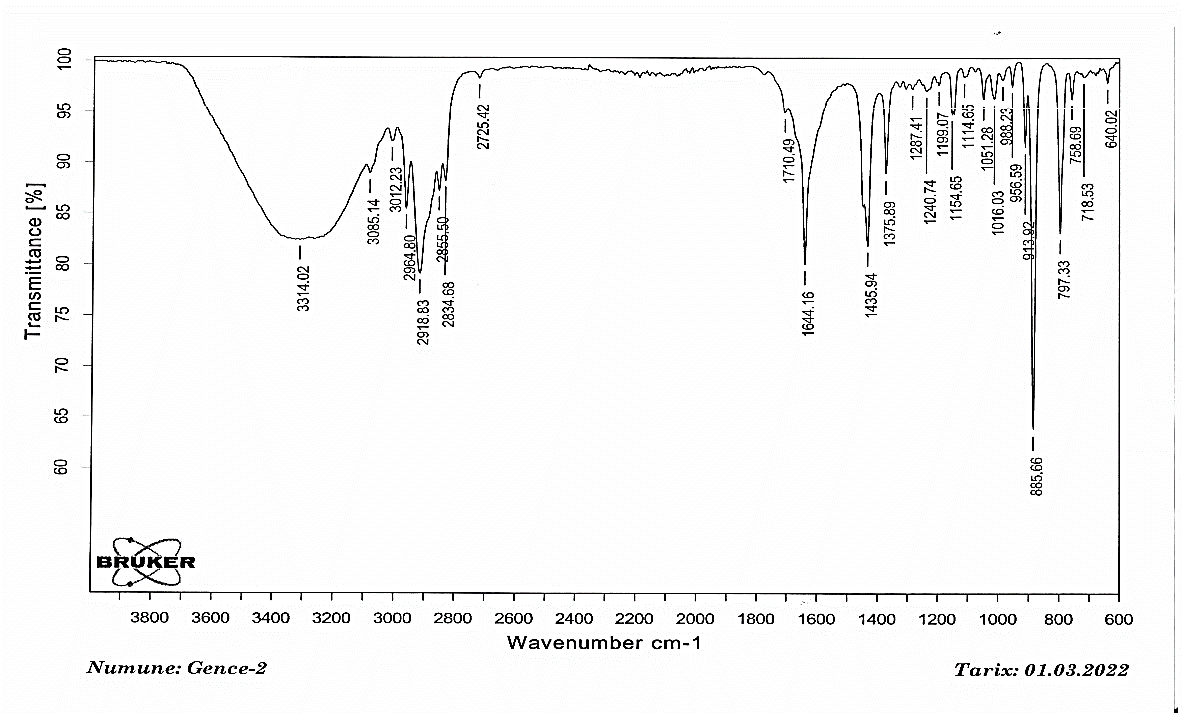STUDY OF THE ESSENTIAL OIL OBTAINED FROM JUNIPER PLANT BY PHYSICAL-CHEMICAL METHODS
UDC 547.913:543.2
Abstract
Plants are natural resource with a perfect structure that can meet many needs of people and show diversity since hundreds of years. All over the world and in our country, plants have been used for a long time in the preparation of tea, spices, perfumes, ointments and medicines used in the treatment of diseases. Essential oils arelarge group of biologically active compounds contained in plants. In the article, the process of extracting essential oil from the juniper plant (Juniperus communis L.) at different yields was studied. Juniper fruit 200.47 g; 200.28 g; when 200.54 g, the average amount of essential oil according to wet raw material was determined to be 1.2±1.4%. The composition of the essential oil obtained from juniper fruit, rich in biologically active substances and important for treatment, was studied by physicochemical methods (chromatographic, Ultraviolet (UV) and Infrared (IR) spectroscopic). In the chromatogram of the essential oil, it was determined that there is a peak of monoterpenoids with a tricyclic structure. Absorption bands obtained as a result of spectral analysis ensure the correctness of the composition of the synthesized essential oil. On the basis of medicinal properties of the juniper plant (Juniperus communis L.), the obtained essential oil can be used in medicine and cosmetology in the preparation of ointments and lotions with various ingredients.
Downloads
Metrics
References
Mohamadi M., Shamspur T., Mostafavi A. J. Essent. Oil Res., 2013, vol. 25, no. 1, pp. 55–61.
Boren K.E. et al. J. Environ. Anal. Chem., 2015, vol. 2, no.2, pp. 100–132.
JungJ. et al. Eur. Food Res. Technol., 2005, vol. 220, pp. 232–237.
Hoer K. et al. J. Agric. Food Chem., 2001, vol. 49, pp. 21–25.
Souza R. et al. Anal. Lett., 2011, vol. 44, pp. 2417–2422.
Feudjio W.M. et al. Food Anal. Methods, 2017, vol. 10, pp. 2539–2548.
Baser K.H.C., Buchbauer G. Handbook of Essential Oils: Science, Technology, and Applications. Boca Raton: Taylor & Francis, 2009, 1128 p.
Pellati F. et al. Rapid Comm. Mass Spectrom., 2013, vol. 27, pp. 591–602.
Selivanova N.V., Samsonova N.V., Qusakova M.A., Boqolichin K.Q., Boqdanova M.B. Lesn. Journal, 2019, no. 6, pp. 241–254. DOI: 10.37482/0536-1036-2019-6-241. (in Russ.).
GOST ISO 875-2014. Masla efirnyye. Metod opredeleniya rastvorimosti v etilovom spirte. [GOST ISO 875-2014. Es-sential oils. Method for determining solubility in ethyl alcohol]. Moscow, 2015, 11 p. (in Russ.).
Standarty po ISO/TC 54. Essential oils. [Standards for ISO/TC 54. Essential oils]. URL: https://www.iso.org/ru/committee/48956/x/catalogue/p/1/u/0/w/0/d/0. (in Russ.).
Sciarrone D. et al. J. Chromatogr. A., 2011, vol. 1218, pp. 137–142.
Russo M. et al. J. Essent. Oil Res., 2015, vol. 27, no. 4, pp. 307–315.
Waksmundzka-Hajnos M., Sherma J., Kowalska T. Thin Layer Chromatography in Phytochemistry. Chromatographic science series, Boca Raton: CRC Press, 2008, vol. 99, 896 p.
Tashmatov Z.O., Eshbakova K.A., Bobakulov Kh.M. Chem. Nat. Compd., 2011, vol. 47, pp. 440–441. DOI: 10.1007/s10600-011-9955-8.
Skaltsa H.D., Lazari D.M., Kyriazopoulos P., Golegou S., Triantaphyllidis S., Sokovic M., Kypriotakis Z.J. Essent. Oil Res., 2005, vol. 17, pp. 232–235. DOI: 10.1080/10412905.2005.9698886.
Karimov A.M., Ostroushko Yu.V., Botirov E.Kh. Chem. Nat. Compd., 2019, vol. 55, pp. 545–546. DOI: 10.1007/s10600-019-02737-0.
Cicek M., Demirci B., Yilmaz G., Baser K.H.C. Nat. Prod. Res., 2011, vol. 25, pp. 1720–1726. DOI: 10.1080/14786419.2010.512997.
Sazhina N.N., Lapshin P.V., Zagoskina N.V., Misin V.M. Khimiya rastitel'nogo syr'ya, 2015, no. 2, pp. 169–176. (in Russ.).
Sazhina N.N., Lapshin P.V., Zagoskina N.V., Pal'mina N.P. Khimiya rastitel'nogo syr'ya,2019, no. 2, pp. 83–90. (in Russ.).
Olennikov D.N., Zilfikarov I.N., Ibragimov T.A., Toropova A.A., Tankhayeva N.L. Khimiya rastitel'nogo syr'ya, 2010, no. 3, pp.83–90. (in Russ.).
Lahlou M. Essensial Oils and Fragrance Compounds: Bioactivity and Mechanisms of Action. Flavour and Fragrance Journal, 2004, no. 19, pp. 159–165.
Reshetnikov V.N., Shutova A.G., Spiridovich E.V. Doklady Natsional’noi akademii nauk Belarusi, 2015, vol. 59, no. 1, pp. 74–77. (in Russ.)

Copyright (c) 2023 chemistry of plant raw material

This work is licensed under a Creative Commons Attribution 4.0 International License.

This work is licensed under a Creative Commons Attribution 4.0 International License.
The authors, which are published in this journal, agree to the following conditions:
1. Authors retain the copyright to the work and transfer to the journal the right of the first publication along with the work, at the same time licensing it under the terms of the Creative Commons Attribution License, which allows others to distribute this work with the obligatory indication of the authorship of this work and a link to the original publication in this journal .
2. The authors retain the right to enter into separate, additional contractual agreements for the non-exclusive distribution of the version of the work published by this journal (for example, to place it in the university depository or to publish it in a book), with reference to the original publication in this journal.
3. Authors are allowed to post their work on the Internet (for example, in a university repository or on their personal website) before and during the review process of this journal, as this may lead to a productive discussion, as well as more links to this published work.











